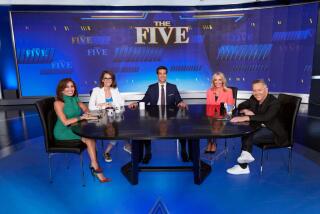Cable Channels: Nice but Not the Big 3
- Share via
So network television is finished! The Big Three are dinosaurs turning to dust! And the victor’s name is Cable? At least you’d think so, from any regular reading of these pages in The Times.
But wait just a remote-controlled minute. Maybe regulars like Rick Du Brow, and the others who report on TV for The Times, aren’t receiving a clear picture (a typical cable problem, isn’t it?).
Well worry not, Rick and the Rest of You, I have the antidote. Just push the fine-tuning button for this better picture of TV today. You’ll see that cable is not yet the 2,000-pound gorilla you so often describe. And you’ll no longer be Gorillas in the Myths.
First, the Ratings Myth. In cable, a 2 rating is a major event. Champagne corks pop and careers soar. But a 2 rating is so small (network hits commonly draw 15-plus) that no network could tolerate it. Any network vice president who delivered a 2 would be driven out of town as fast as his BMW could take him. The Du Brows would never let CBS get away with a 2, but they’ll let Lifetime or USA cable do it.
The Subscriber Myth. Rarely can a Times writer comment on a given basic cable channel without glorifying some enormous subscriber base in the millions of viewers. But push pause a second here. Subscribers are not viewers, they’re just available as viewers. Cable customers don’t subscribe to these individual channels, they buy packages. Each channel within the package enthusiastically claims each loyal subscriber is its own, with columnists dutifully reporting what appears to be glorious millions of actual viewers. But try cramming all those millions into a 2 rating. Easier to get Roseanne into a Size 4.
Third is the MTV Myth, putting truth between rock and a strange place. Media coverage such as a recent cover story in Sunday Calendar consistently glorifies MTV as the dominant mega-hit of our time. But the documentaries of the Discovery Channel have long and often outrated the rock videos of MTV. Carl Sagan beats Madonna? Now there’s a cover story!
The Cable “Network” Myth persistently calls these channels “networks,” thereby elevating them to symbolic equality with ABC, CBS and NBC. But that’s like saying a Cessna and a 747 are both airplanes.
None of these “networks” can claim the 200-plus station chain of affiliates. None have actual viewer bases in the scores of millions, nor thousand-employee news divisions, nor any of the sheer and simple depth that signifies a true network. Yet reporters on the TV beat let cable call the shots, constantly using the name Network.
Fifth is the CNN Myth, so often lifting the Cable News Network to a yet undeserved level of importance. Well, the Gulf War ratings bubble has burst, floating CNN back down to the world of the 2 rating. Yet Tom, Dan and Peter typically still draw a 10-plus rating. So the Big 3 newscasts outrate CNN by about 15-1, yet the CNN myth prevails.
This is not to denigrate CNN and its formidable 24-hour effort. But even with a decade of determination, CNN has made no ratings breakthrough, generating what can only be called a large cult following at best. Don’t misunderstand. CNN is a jewel that would make the First Amendment authors proud. But perspective must prevail. CNN is still just a promising child nipping at the heels of the big kids.
The Pay Cable Myth holds that the HBOs and Showtimes have taken the crown from the networks in big-budget entertainment. Yet the myth-makers ignore pay cable’s troubling rate of yearly renewals, often estimated as low as 50%, leaving pay cable in a constant struggle to lure new viewers just to keep even with those who are annually lost.
Critics and columnists love to equate the HBOs with the NBCs. The pay channels do offer some original and innovative programming, often on a par with the peacock. But a handful of new shows, which are then rerun a dozen or so times a month, just don’t measure up to the networks’ steady output of new product. Imagine if ABC took the “Sunday Night Movie” and reran it again on Tuesday night, Wednesday morning and three times on Friday! Unthinkable? Yes, if you really are a network.
Last is the Commercial Myth, an illusion of equality created by all those commercials you see on cable. But low ratings result in limited income. And without the additional subscriber fees that neighborhood cable systems pay for this programming, the cable networks (now they’ve got me doing it) could not survive. These fees, from the viewer’s package charges by the way, are in effect a subsidy for cable broadcasters. If CBS demanded a subsidy from viewers, imagine the uproar from the same critics who don’t mind at all when cable does it.
None of this is to criticize cable with its great progress and even greater potential. Rather, the problem is the press, acting more as a press agent, curiously eager to bestow credentials that cable has yet to earn. Therein lies the Great Danger.
The Cable Myths have resulted in a Doomsday Cloud hovering over the networks. So far it’s only a perception, but perceptions have a nasty habit of being reality if they are not quickly unmasked.
There is something about network television that is fundamentally inherent to the American spirit. The networks are a binding force for the entire country, providing frequent common experiences and emotions for the nation as a whole. Whether those moments are a heart-tugging “MASH” finale, a provocative “20/20” expose, a “Laugh-In” or a “Cosby”--and certainly a Johnny monologue each night--somehow they all hold us together.
So if Rick and the Rest of You will focus through the myths and reflect instead on TV’s true state, perhaps ABC, CBS and NBC will once again be held in proper esteem as the imperfect but essential national treasures they have always been.
More to Read
The complete guide to home viewing
Get Screen Gab for everything about the TV shows and streaming movies everyone’s talking about.
You may occasionally receive promotional content from the Los Angeles Times.






